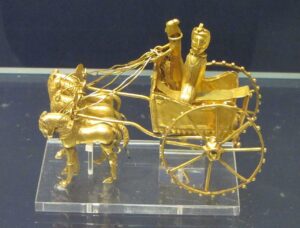WorldWide: Oxus River Valley, Biblical Archaeology Review (24:2), Mar/Apr 1998.

Oxus Gold Model Chariot, By BabelStone – Own work, CC BY-SA 3.0, https://commons.wikimedia.org/w/index.php?curid=18869637
A Persian nobleman enjoys the view from his chariot as his driver takes control of the reins. Made of solid gold, the 4-inch-long chariot model was reportedly found in 1877 with 150 gold and silver artifacts and 1,500 coins on the banks of the Oxus River, on the northern border of modern Afghanistan.
The Oxus Treasure, as the hoard has come to be known, dates primarily to the fifth and fourth centuries B.C., when the Achaemenid dynasty led the Persian empire. The richness of the artifacts suggests they may have belonged to the rulers themselves. A seal thought to belong to the great Achaemenid leader Darius I (522–486 B.C.) shows the king in a similar chariot with knobbed wheels, which may have been used on full-scale chariots to control slipping.
The gold chariot bears evidence that the Persians adopted artistic and cultural elements from the various cultures they subjugated, from Libya in the west to the Indus region in the east.
Embossed on the front of the chariot is the smiling face of Bes, the Egyptian god of humor and domestic well-being. The chariot driver’s outfit—a domed cap with earflaps, a long-sleeve belted tunic, and loose trousers—is typical of the Medes, a neighboring Indo-Iranian tribe that came under Persian control during the reign of Cyrus the Great (559–530 B.C.)—just ten years before Cyrus conquered Babylonia and allowed the exiled Jews to return to Jerusalem and rebuild their Temple.



